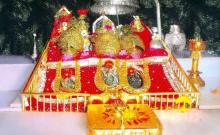
Vaishno Devi Temple
Vaishno Devi Temple, ranked as the second most frequented Hindu pilgrimage destination in India. The Mata Vaishno Devi Temple is situated amidst the Trikuta Hills in Katra, Jammu & Kashmir.
Hindu worshippers from around the globe journey to this renowned sacred site, believed to be where the Mother Goddess or Mata Vaishno Devi grants their desires.
This holy location holds paramount significance as a Shaktipeeth, tracing back to the belief that the skull of the Goddess Sati landed here.
Within the Mata Vaishno Devi Cave, the goddess manifests in the form of a 5.5 feet tall rock with three heads, known as Pindies.
During the pilgrimage to Mata Vaishno Devi, devotees adhere to the tradition of presenting offerings to Mata, including chunris (red-colored drapes), sarees, dried fruits, silver or gold ornaments, cholas, and flowers, among others.
Mythology - Mata Vaishno Devi Temple
Mahakali, Maha Saraswati and Mahalakshmi are worshiped at this place in the form of Bhagwati Shakti. Three sacred 'pindis' or stones are enshrined in a cave-like temple, which are worshiped as symbols of the above three Shakti-forms.
Here, despite being made of the same rock, the color and structure of these three bodies are different. The pale white stone on the left most symbolizes Goddess Saraswati, the yellow-red stone in the middle symbolizes the prestige of Goddess Lakshmi, and the black stone on its left represents Goddess Kali.
Mythology - 1
According to legend, Vaishno Devi was initially called Trikuta and at that time, when she was nine years old, she was engaged in devotion to Lord Rama, an incarnation of Lord Vishnu.
At the same time, when Lord Rama passed by in search of Mother Sita who had been abducted by the demon king Ravana, he came to pay her respects and ask for a boon.
Vaishno Devi respected him and advised him to go to the Trikuta Mountains to answer his prayers and gave him the necessary materials for protection.
Mata Vaishno Devi incarnated as Vaishnavi and received a divine mandate from her creators to dwell on Earth, dedicating her existence to achieving a profound state of consciousness.
Subsequently, Lord Rama instructed her to establish an Ashram at the foot of Trikuta Hills, where she could engage in meditation and spiritual growth. Vaishnavi faithfully carried out these directives.
Mythology - 2
According to another legend, 700 years ago Vaishno Devi, a devotee of Lord Vishnu, took a vow of celibacy.
Upon settling in Trikuta Hills near Katra, the Great yogi Guru Gorakh Nathji sent his disciple, Bhairon Nath, to assess Vaishnavi's spiritual progress.
However, Bhairon Nath gradually deviated from his purpose, falling in love with Vaishnavi and persistently pressuring her for marriage.
In order to safeguard her meditation from disturbances, Vaishnavi retreated to the mountains, pursued by Bhairon Nath.
The Goddess felt thirsty and while running away shot an arrow into the ground, which produced a lake. Her footprints are still present at that place.
She then entered the cave at Ardhkwarni, where she assumed the form of Mahakali and killed Bhairon Nath. Where Bhairon Nath's head fell, his temple was built at that place.
Many believe that the face stone of the cave is in the shape of the head of Bhairon Nath, who was forgiven by the goddess upon realizing it.
In his final moments, Bhairon Nath comprehended his errors and sought forgiveness. Mata Vaishno Devi not only pardoned him but also bestowed a boon upon him.
It is a requisite for each pilgrim embarking on the Mata Vaishno Devi Yatra to witness the presence of Bhairon after paying respects to the goddess. Only upon completing this sequence would the pilgrimage be considered fulfilled.
Mythology - 3
According to another legend, this holy cave was built by the Pandavas during the Mahabharata.
The first reference to Vaishno Devi appears in the Mahabharata, in ancient times, when the Pandavas and Kauravas were preparing for war.
According to this legend, Arjuna, in consultation with Lord Krishna, desirous of receiving the blessings of the Mother Goddess to achieve victory, adopted her meditation method.
History of Mata Vaishno Devi Temple
The establishment of the Mata Vaishno Devi Shrine Board took place in 1986, marking the commencement of a significant influx of Hindu pilgrims to this highly revered site in Jammu.
The sacred cavern of Mata Vaishno Devi is attributed to its discovery by Pandit Sridhar, a Hindu priest.
According to the narrative, Goddess Vaishnavi manifested in the priest's dreams, guiding him to locate her dwelling on the Trikuta Hills.
Following her ethereal guidance, the priest embarked on the journey described in his dream and successfully located the cave as instructed.
Mata Vaishno Devi materialized before him, imparting her blessings by granting him four sons and designating him as the guardian of the cave.
To this day, the descendants of Pandit Shridhar honor this commitment.
Best Time To Visit Mata Vaishno Devi Temple
"Chalo Bulawa aaya hai maata ne bulaya hai" (Come on, the call has come, mother has called). This is proverb for Maata Vaishno devi.
The Mata Vaishno Devi Temple remains accessible year-round, with the prime period for a visit being from March to October.
Devotees often choose to schedule their pilgrimage during the sacred Navratra period as well. Here are some suggestions.
☀️Summer (March to June)
Undoubtedly, the most favorable months for a visit to Vaishno Devi are May, June, and July.
While the daytime offers tranquility, the temperatures noticeably drop in the evening, creating a pleasant atmosphere for darshan.
It's advisable to have lightweight woolens handy, as even though the summer climate stays cool, the higher altitude can bring chilly evenings. Moreover, these months witness a comparatively lower influx of visitors.
⛈️Monsoon (July to October)
The monsoon season presents an ideal opportunity to discover the natural splendor of the region.
As the area receives varying degrees of rainfall, lush green landscapes emerge, adorned with cascading waterfalls.
Nonetheless, embarking on a Yatra during this period can be perilous due to the potential for abrupt mudslides.
However, as this is the off-season, budget-conscious travelers can secure accommodations at affordable rates.
❄️Winter (November to February)
Due to its elevated location, Mata Vaishno Devi witnesses substantial snowfall throughout the winter season.
Unless you are accompanied by elderly individuals or children, visitors can consider venturing there during this time as it offers a unique experience.
Despite the sub-zero temperatures, the Holy Cave remains accessible, and amidst the snow, one can observe pilgrims journeying to pay their respects to the Holy Mother.
Official Website - https://www.maavaishnodevi.org
How to reach Vaishno Devi by flight
Jammu Airport, also known as Satwari Airport (IXJ), stands as the closest air terminal catering to Katra. There are routine flight operations connecting Katra via this airport.
Upon arrival, simply hire a taxi from the airport, you'll arrive in Katra within an hour.
Alternatively, buses operate along this route as well. Interestingly, within Katra, helicopter facilities are accessible to transport you from the main Bhawan to Sanjhhi Chat, a distance of around 5 km from the revered Bhawan.
How to reach Vaishno Devi by train
The Katra railway station, known as Shri Mata Vaishno Devi Katra railway station (SVDK), serves as the closest rail point to the sacred Vaishno Devi cave.
There are frequent train services operating from various prominent cities across India, which used to terminate at Jammu Tawi earlier.
Right beside the railway station, you can find comfortable lodging options. The Shri Shakti EXP train, commencing its journey from New Delhi (NDLS) to SVDK stands out as the optimal means to reach Vaishno Devi.
How to reach Vaishno Devi by road
Jammu maintains excellent road connectivity with the rest of India. National Highway No. 1A traverses through Jammu en route to Srinagar.
Jammu and Katra both have consistent bus services originating from significant cities in Northern India.
A multitude of standard and deluxe buses operated by State Road Transport Corporations and private companies establish connections between Jammu and key cities and towns in the North India region.
Things To Know
What are the necessary items to bring with me before embarking on the pilgrimage?
Kindly make sure to have the following items with you when you head to Bhawan for darshan:
- Your Yatra slip
- Please note that video shooting is not permitted.
- Any documentation related to room reservations, if applicable.
- One or two spare garments, depending on the season and weather.
- A flashlight and an umbrella.
- If you plan to walk, bring along canvas shoes.
Question: What should I do before embarking on the pilgrimage from Katra?
Answer: Before starting your journey to Bhawan for darshans, please ensure the following:
- Obtain a yatra slip (parchi) from the Yatra Registration Counter at the Katra General Bus Stand. The yatra slip is provided free of charge and can be obtained between 6 A.M. and 10 P.M.
- Note that video cameras are not allowed on the track.
- If you have booked a room for Bhawan, Sanji Chhat, or Adhkwari, collect the necessary documents from the Enquiry and Reservation offices at Shakti Bhawan or Niharika. These documents will be required at the location for which the room is booked.
- Avoid carrying excessive jewelry or cash with you.
Question: What is the helicopter price?
Answer: Ticket price for one-way journey: Rs. 1830 per person. Vist this link for more info.
Question: How and where can I hire ponies and palanquins?
Answer: To hire registered ponies, palanquins, or pithoos, pilgrims should approach the contractor's offices at Bhawan, Adhkwari, or Katra.
The rates for these services are approved by the government and can be verified on signboards placed by the Board at prominent locations along the track.
Before availing of these services, devotees should make a note of the registration number of the individuals providing them for reference if needed. In case of any issues with the contractor's office, pilgrims can also contact the field offices of the Shrine Board at the mentioned locations.
Question: What is the procedure for having darshans (sacred views)?
Answer: Before embarking on the journey from Katra, pilgrims should register themselves at the yatra registration counter located at the Katra Bus Stand.
The yatra slip is provided free of charge and can be easily obtained from the yatra registration counter, which is open from 6 A.M. in the morning until 10 P.M. in the evening.
During peak periods when the number of pilgrims in Katra exceeds the capacity at Bhawan, pilgrims may be held back in Katra and issued a temporary waiting group, which is later converted into a final slip on a first-come-first-served basis.
The yatra slip obtained in Katra must first be verified at the Banganga slip check post and subsequently at the Bhawan slip check post.
Upon reaching Bhawan, a new group number is assigned to the pilgrims, which is stamped on the yatra slip obtained in Katra. This group number is crucial for gaining access to darshans at Bhawan.
Question: What is the distance from Katra to the Shrine, and how long does it typically take to reach Bhawan?
Answer: The sacred cave of Vaishno Devi is located 12 kilometers away from Darshani Deodi, which is the starting point for the on-foot pilgrimage.
The duration of the on-foot journey varies depending on your health, age, and the composition of your group. However, for an average, healthy individual, it takes approximately four to five hours to complete the journey on foot.
Question: Are there sufficient catering facilities available along the route, including milk for children?
Answer: The Shrine Board has established adequate catering facilities in the form of dining establishments (Bhojanalayas) and view points along the route. In addition to various food items, these facilities also provide milk for children.
Private shops offering a variety of snacks and refreshments can also be found at different locations.

